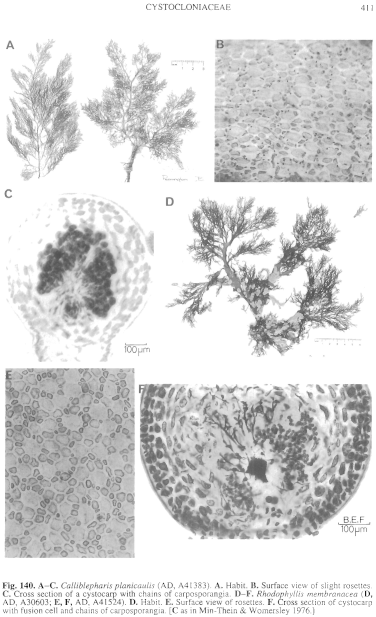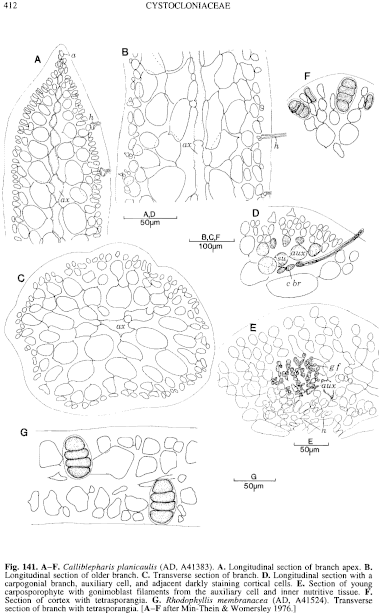|
|
|
|
|
|||||||||||
|
Electronic Flora of South Australia Species Fact Sheet
Phylum Rhodophyta – Class Florideophyceae – Order Gigartinales – Family Cystocloniaceae
Selected citations: J. Agardh 1876: 365. Chapman 1979: 350. Cotton 1908: 99. De Toni 1897: 344. Kützing 1869: 20, pl. 53a-c. Kylin 1932: 42. Min-Thein & Womersley 1976: 95, fig. 62A.
Synonyms
Halymenia membranacea Harvey 1844: 448.
Rhodymenia membranacea (Harvey) Harvey ex Hooker & Harvey 1847: 405.
Euthora membranacea (Harvey) J. Agardh 1852: 385.
Stictophyllum membranaceum (Harvey) Kützing 1847: 1; 1849: 874.
Laurencia? membranacea Harvey 1844: 443.
Cladhymenia gunnii Harvey ex Hooker & Harvey 1845: 540. Harvey 1849a: 87, pl. 32. J. Agardh 1852: 386. Kützing 1867: 28, pl. 94a-c.
Callophyllis gunnii (Harvey) Kützing 1849: 746.
Euthora ?gunnii (Harvey) J. Agardh (1852: 386) ex Sonder 1853: 682.
Rhodophyllis gunnii (Harvey) Harvey 1855b: 247; 1859b: 318. J. Agardh 1876: 366. De Toni 1897: 345. Kylin 1932: 42. Lucas 1929a: 17. Lucas & Perrin 1947: 167, fig. 40. May 1965: 409. Millar & Kraft 1993: 15. Min-Thein & Womersley 1976: 91, figs 31, 32, 61B.
Thallus (Fig. 140D) erect, pale to medium red, often grey-brown, (5–) 10–15 cm high, complanately and more or less closely pinnately branched with flat branches (4–) 7–15 mm broad and 0.4–1 mm thick below, bearing laterals (2–) 5–10 mm broad or tapering to slender branches 1–2 mm broad, apices and axils rounded, often marginally proliferous. Holdfast of branched fibres 0.5–2 cm long; epilithic. Structure uniaxial, axial row of cells slightly flexuous, each axial cell with two periaxial cells, the lateral one developing further and the transverse one forming a single cortical cell, with successive axial cells forming alternating pairs of periaxial cells, the lateral ones forming filaments of limited growth; medulla slight, of axial and periaxial filaments with very few rhizoids, cortex single layered, usually with gland cells and with outer rosette cells, rosettes (Fig. 140E) weakly defined, cortical cells developing further in older parts of thallus. Rhodoplasts elongate, becoming ribbon shaped and branched.
Reproduction: Sexual thalli dioecious; procarpic. Carpogonial branches 3 (–4)-celled, borne on inner cortical cells on margins of branches, laterally orientated with a reflexed trichogyne, with the cortex thickening outside the carpogonial branch. Following fertilization, cortical cells outside the procarp become darkly staining and cells inwards from the auxiliary cell cut off small nutritive cells. Following connection between the fertilized carpogonium and auxiliary cell, a single gonimoblast initial develops and fusions occur with adjacent cortical cells forming a fusion cell with radiating gonimoblast filaments with terminal chains of ovoid carposporangia 15–25 µm in diameter and some connections with the nutritive cells and the pericarp. Cystocarps (Fig. 140F) marginal, 0.7–1 mm across, protuberant with a pericarp 4–6 cells thick, without a distinct ostiole. Spermatangia scattered, cut off from rosette cells with 3–4 initials each forming 2–3 ovoid spermatangia.
Tetrasporangia (Fig. 141G) scattered in the cortex of young branches, ovoid, 20–35 µm in diameter, zonately divided.
Lectotype from Georgetown, Tas. (Gunn 1276); in Herb. Hooker, BM; isolectotype in TCD.
Selected specimens: Nuyts Reef, S. Aust., 28–30 m deep (Shepherd, 26.iii.1980; AD, A52309). Masillon I., Isles of St Francis, S. Aust., 13–18 m deep (Shepherd, 5.i.1971; AD, A37999). 4 km W of Waldegrave I., S. Aust., 30 m deep (Branden, 3.vii.1987; AD, A57604). Hopkins I., S. Aust., 33 m deep (Branden, 8.i.1989; AD, A60004). Antechamber Bay, Kangaroo I., S. Aust., drift (Womersley, 18.viii.1948; AD, A8657). Whale Point, West I., S. Aust., 26 m deep (Shepherd, June 1966; AD, A30603). 1.3 km off Cape Northumberland, S. Aust., 15 m deep (Shepherd, 26.x.1977; AD, A55168). Lady Julia Percy I., Vic., 20 m deep (Shepherd, 4.i.1968; AD, A35161). Port Phillip, Vic., 15 m deep S of Cage Buoy (Womersley, 7.iv.1959; AD, A22813). Erith I., Bass Str., 18 m deep (Collings, 19.xii.1990; AD, A60849). Kelso Bay, Tamar Est., Tas., 3–5 m deep (Blackman, 29.iv.1979; AD, A58514). Stapleton Point, Prosser Bay, Tas., 12–15 m deep (Shepherd, 10.ii.1970; AD, A35768). Fluted Cape, Bruny I., Tas., 16 m deep (Shepherd, 10.ii.1972; AD, A41524). Green Cape, N.S.W., 16 m deep (Shepherd, 13.ii.1973; AD, A43036).
Distribution: Nuyts Reef, S. Aust., to Mona Vale, N.S.W., and around Tasmania.
Taxonomic notes: Min-Thein & Womersley (1976, p. 97) doubted whether R. membranacea and R. gunnii were distinct species, and it now seems appropriate to synonymise the latter under the earlier R. membranacea. Harvey (1844) described Laurencia? membranacea based on a sterile specimen (Gunn 1277) from Georgetown, Tas., and also Halymenia membranacea based on tetrasporangial specimens (Gunn 1276) from the same locality. L.? membranacea was later referred to as Cladhymenia gunnii by Hooker & Harvey (1845, p. 540), and the type sheet (Gunn 1277) in the BM bears both names. Gunn 1276, being a fertile specimen, is selected as lectotype of R. membranacea.
The species is variable in form, probably dependent on age and degree of water movement. Younger plants in moderate water movement tend to have broader, rounded apices, while those with tapering, narrower, apices may be older and from greater water movement. Gland cells are usually present but vary greatly in abundance. It is essentially a deep water species.
References:
AGARDH, J.G. (1852). Species Genera et Ordines Algarum. Vol. 2, Part 2, pp. 337–720. (Gleerup: Lund.)
AGARDH, J.G. (1876). Species Genera et Ordines Algarum. Vol. 3, Part 1 - Epicrisis systematis Floridearum, pp. i-vii, 1–724. (Weigel: Leipzig.)
CHAPMAN, V.J. (1979). The marine algae of New Zealand. Part DI Rhodophyceae. Issue 4: Gigartinales. (Cramer: Germany.)
COTTON, A.D. (1908). The New Zealand species of Rhodophyllis. Kew Bull. 1908, 97–102.
DE TONI, G.B. (1897). Sylloge Algarum omnium hucusque Cognitarum. Vol. 4. Florideae. Sect. 1, pp. 1–388. (Padua.)
HARVEY, W.H. (1844). Algae of Tasmania. Lond. J. Bot. 3, 428–454.
HARVEY, W.H. (1849a). Nereis Australis, pp. 65–124, Plates 26–50. (Reeve: London.)
HARVEY, W.H. (1855b). Algae. In Hooker, J.D., The Botany of the Antarctic Voyage. II. Flora Novae-Zelandiae. Part II, pp. 211–266, Plates 107–121.
HARVEY, W.H. (1859b). Algae. In Hooker, J.D., The Botany of the Antarctic Voyage. Flora Tasmaniae. Vol. II, pp. 282–320.
HARVEY, W.H. (1863). Phycologia Australica. Vol. 5, Plates 241–300, synop., pp. i-lxxiii. (Reeve: London.)
HOOKER, J.D. & HARVEY, W.H. (1845). Algae Novae Zelandiae. Lond. J. Bot. 4, 521–551.
HOOKER, J.D. & HARVEY, W.H. (1847). Algae Tasmanicae. Lond. J. Bot. 6, 397–417.
KÜTZING, F.T. (1847). Diagnosen and Bemerkungen zu neuen oder kritischen Algen. Bot. Zeit. 5, 1–5, 22–25, 33–38, 52–55, 164–167, 177–180, 193–198, 219–223.
KÜTZING, F.T. (1849). Species Algarum. (Leipzig.)
KÜTZING, F.T. (1867). Tabulae Phycologicae. Vol. 17. (Nordhausen.)
KÜTZING, F.T. (1869). Tabulae Phycologicae. Vol. 19. (Nordhausen.)
KYLIN, H. (1932). Die Florideenordnung Gigartinales. Lunds Univ. Årsskr. N.F. Avd. 2, 28 (8), 1–88, Plates 1–28.
LUCAS, A.H.S. & PERRIN, F. (1947). The Seaweeds of South Australia. Part 2. The Red Seaweeds. (Govt Printer: Adelaide.)
LUCAS, A.H.S. (1929a). The marine algae of Tasmania. Pap. Proc. R. Soc. Tasm. 1928, 6–27.
MAY, V. (1965). A census and key to the species of Rhodophyceae (red algae) recorded from Australia. Contr. N.S.W. natn. Herb. 3, 349–429.
MILLAR, A.J.K. & KRAFT, G.T. (1993). Catalogue of Marine and Freshwater Red Algae (Rhodophyta) of New South Wales, including Lord Howe Island, South-western Pacific. Aust. Syst. Bot. 6, 1–90.
MIN-THEIN, U. & WOMERSLEY, H.B.S. (1976). Studies on southern Australian taxa of Solieriaceae, Rhabdoniaceae and Rhodophyllidaceae (Rhodophyta). Aust. J. Bot. 24, 1–166.
SONDER, O.W. (1853). Plantae Muellerianae. Algae. Linnaea 25, 657–709.
The Marine Benthic Flora of Southern Australia Part IIIA complete list of references.
Publication:
Womersley, H.B.S. (14 January, 1994)
The Marine Benthic Flora of Southern Australia
Rhodophyta. Part IIIA, Bangiophyceae and Florideophyceae (to Gigartinales)
Reproduced with permission from The Marine Benthic Flora of Southern Australia Part IIIA 1994, by H.B.S. Womersley. Australian Biological Resources Study, Canberra. Copyright Commonwealth of Australia.
Illustrations in Womersley Part IIIA, 1994: FIGS 140 D–F, 141G.

Figure 140 enlarge
Fig. 140. A–C. Calliblepharis planicaulis (AD, A41383). A. Habit. B. Surface view of slight rosettes. C. Cross section of a cystocarp with chains of carposporangia. D–F. Rhodophyllis membranacea (D, AD, A30603; E, F, AD, A41524). D. Habit. E. Surface view of rosettes. F. Cross section of cystocarp with fusion cell and chains of carposporangia. [C as in MM-Thein & Womersley 1976.]

Figure 141 enlarge
Fig. 141. A–F. Calliblepharis planicaulis (AD, A41383). A. Longitudinal section of branch apex. B. Longitudinal section of older branch. C. Transverse section of branch. D. Longitudinal section with a carpogonial branch, auxiliary cell, and adjacent darkly staining cortical cells. E. Section of young carposporophyte with gonimoblast filaments from the auxiliary cell and inner nutritive tissue. F. Section of cortex with tetrasporangia. G. Rhodophyllis membranacea (AD, A41524). Transverse section of branch with tetrasporangia. [A–F after MM-Thein & Womersley 1976.]

|
Email Contact: State Herbarium of South Australia |

|